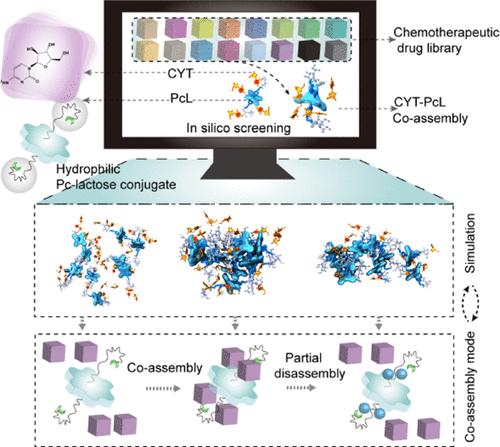具有定制功能的酞菁类药物共聚物的分子设计
IF 14.4
1区 化学
Q1 CHEMISTRY, MULTIDISCIPLINARY
引用次数: 0
摘要
具有药物负载、组织靶向和释放、治疗和/或成像等定制功能的共聚物已被广泛研究并应用于生物医学领域。从分子支架的 "酞菁-化学治疗药物 "分子组合的结构筛选、相关制造原理的探索到特定设计的预期活性验证,这些共组装体的全新设计取决于涉及各种设计策略之间协同作用的综合方法。在这里,我们提出了一种结合计算和实验的综合方法,从零开始设计共组装纳米粒子。这种纳米共组装(此处称为 NanoPC)由酞菁基支架组成,内含化疗药物,旨在通过光成像引导针对肿瘤的超敏化疗。我们的设计从选择不易聚集的酞菁衍生物开始,然后通过计算筛选出涵盖各类化疗药物的共组装分子。为便于高效、准确地评估共组装能力,我们利用小系统作为替代物,通过增强采样和统计力学,在全原子水平上进行自由能计算,从而高效、准确地评估共组装能力。由酞菁 PcL 和阿糖胞苷(CYT)组成的最终顶级 NanoPC 候选物可将肿瘤/肝脏的荧光强度比大幅提高 21.5 倍,并以 pH 依赖性方式实现更高的抗肿瘤效率。因此,本文提出的设计方法具有潜在的模式,可为设计和开发具有定制功能的共组装纳米药物及在生物医学中的应用提供思路和参考。本文章由计算机程序翻译,如有差异,请以英文原文为准。

Molecular Design of Phthalocyanine-Based Drug Coassembly with Tailored Function
Coassemblies with tailored functions, such as drug loading, tissue targeting and releasing, therapeutic and/or imaging purposes, and so on, have been widely studied and applied in biomedicine. De novo design of these coassemblies hinges on an integrated approach involving synergy between various design strategies, ranging from structure screening of combinations of “phthalocyanine-chemotherapeutic drug” molecules for molecular scaffolds, exploration of related fabrication principles to verification of intended activity of specific designs. Here, we propose an integrated approach combining computation and experiments to design from scratch coassembled nanoparticles. This nanocoassembly, termed NanoPC here, consists of phthalocyanine-based scaffolds hosting chemotherapeutic drugs, aimed at hypersensitive chemotherapy guided by photoimaging for targeting tumors. Our design starts from the selection of phthalocyanine derivatives that are not aggregation-prone, followed by computational screening of coassembled molecules covering various categories of chemotherapy drugs. To facilitate an efficient and accurate assessment of coassembly capabilities, we utilize small systems as surrogates to enable free-energy calculations at all-atom levels facilitated with enhanced sampling and statistical mechanics for efficient and accurate evaluation of coassembly ability. The final top NanoPC candidate, comprised of phthalocyanine PcL and cytarabine (CYT), can greatly increase the fluorescence intensity ratio of tumor/liver by 21.5 times and achieve higher antitumor efficiency in a pH-dependent manner. Therefore, the designing approach proposed here has a potential pattern, which can provide ideas and references for the design and development of coassembled nanodrugs with tailored functions and applications in biomedicine.
求助全文
通过发布文献求助,成功后即可免费获取论文全文。
去求助
来源期刊
CiteScore
24.40
自引率
6.00%
发文量
2398
审稿时长
1.6 months
期刊介绍:
The flagship journal of the American Chemical Society, known as the Journal of the American Chemical Society (JACS), has been a prestigious publication since its establishment in 1879. It holds a preeminent position in the field of chemistry and related interdisciplinary sciences. JACS is committed to disseminating cutting-edge research papers, covering a wide range of topics, and encompasses approximately 19,000 pages of Articles, Communications, and Perspectives annually. With a weekly publication frequency, JACS plays a vital role in advancing the field of chemistry by providing essential research.

 求助内容:
求助内容: 应助结果提醒方式:
应助结果提醒方式:


